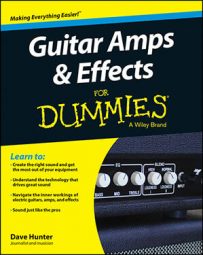The term hollowbody electrics refers to guitars intended for use primarily as electric guitars but which have fully hollow — in other words, acoustic — bodies. These hollowbody electrics did evolve, however, from archtop acoustic guitars that were popular on the jazz, swing, and dance-band scenes before the electric guitar emerged.
In fact most of the first electric guitars made were exactly these, with electromagnetic pickups added either at the factory or post-factory by players themselves. Therefore, hollowbody electric guitars are sometimes referred to as archtop electric guitars (and they can be entirely hollow or partly solid).
![[Credit: Photograph courtesy of Dave Matchette; guitar courtesy of Elderly Instruments]](https://www.dummies.com/wp-content/uploads/444416.image0.jpg)
The hollowbody electric is where the electric guitar was born. There were a few novel efforts at birthing an electric guitar in the 1930s that took quite a different form, but the natural way to go was to put a pickup on the acoustic archtop guitars that already existed, as Gibson did with its ES-150 in 1936.
(These archtops, rather than flat-tops, tended to be the guitars in use by professional players in larger bands at the time, the ones who most needed to be louder.) So the electric guitar was essentially born in this format simply in an effort to amplify the guitar et al.
But the archtop acoustic guitar with built-in electromagnetic pickup soon became known for its own particular sound, which was very different from that of a flat-top acoustic with magnetic soundhole pickup or a piezo pickup mounted under its bridge saddle, which was more of an attempt to simply make the sound of that type of acoustic guitar loud enough to be heard in a large venue.
Given its varied styles and formats, the hollowbody electric category is a broad church, encompassing a lot of different sonic aims. All of its members, however, share the commonality that they are fully acoustic guitars but ones that are intended to be played amped-up.

